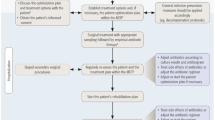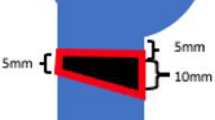Abstract
Background
If some predictable factors that affect the treatment results of low-intensity pulsed ultrasound (LIPUS) for delayed union or nonunion could be determined, these might provide us with suggestions for whether LIPUS should be used as an alternative treatment for surgery or an adjuvant therapy after surgery. Therefore, the objective of the present study was to determine what factors affected failure of fracture healing after LIPUS for delayed unions and nonunions.
Methods
A one-year observational retrospective cohort study was conducted with a consecutive cohort of 101 delayed unions and 50 nonunions after long bone fractures that were treated with LIPUS between May 1998 and April 2007. The main outcome measure was radiographic determination of osseous bone union status within one year after start of LIPUS therapy. Statistical evaluation was used to recognize predictable factors that affect treatment results of LIPUS for delayed union and nonunion.
Results
Delayed union group (n = 101): Seventy-five delayed unions (74.3 %) united without an additional major surgical intervention. Failure of LIPUS therapy was associated with types of nonunion (atrophic/oligotrophic vs. hypertrophic, relative risk 23.72 [95 % CI 1.20–11.5], p < 0.01), instability at fracture site (unstable vs. stable, relative risk 3.03 [95 % CI 1.67–5.49], p < 0.001), and maximum fracture gap size not less than 9 mm (relative risk 3.30 [95 % CI 1.68–6.45]). Nonunion group (n = 50): Thirty-four nonunions (68.0 %) united without an additional major surgical intervention. Failure of LIPUS therapy was associated with method of fixation (intramedullary nail vs. others, relative risk 4.50 [95 % CI 1.69–12.00], p < 0.001), instability at fracture site (unstable vs. stable, relative risk 4.56 [95 % CI 2.20–9.43], p < 0.0001), and maximum fracture gap size not less than 8 mm (relative risk 5.09 [95 % CI 1.65–15.67]).
Conclusions
LIPUS should be applied as an adjuvant therapy in combination with surgical intervention for an established atrophic nonunion with instability and/or with larger fracture gap.


Similar content being viewed by others
References
Duarte LR. The stimulation of bone growth by ultrasound. Arch Orthop Trauma Surg. 1983;101:153–9.
Watanabe Y, Matsushita T, Bhandari M, Zdero R, Schemitsch EH. Ultrasound for fracture healing: current evidence. J Orthop Trauma. 2010;24(Suppl 1):S56–61.
Heckman JD, Ryaby JP, McCabe J, Frey JJ, Kilcoyne RF. Acceleration of tibial fracture-healing by non-invasive, low-intensity pulsed ultrasound. J Bone Joint Surg Am. 1994;76:26–34.
Kristiansen TK, Ryaby JP, McCabe J, Frey JJ, Roe LR. Accelerated healing of distal radial fractures with the use of specific, low-intensity ultrasound. A multicenter, prospective, randomized, double-blind, placebo-controlled study. J Bone Joint Surg Am. 1997;79:961–73.
Leung KS, Lee WS, Tsui HF, Liu PP, Cheung WH. Complex tibial fracture outcomes following treatment with low-intensity pulsed ultrasound. Ultrasound Med Biol. 2004;30:389–95.
Nolte PA, van der Krans A, Patka P, Janssen IM, Ryaby JP, Albers GH. Low-intensity pulsed ultrasound in the treatment of nonunions. J Trauma. 2001;51:693–703.
Mayr E, Frankel V, Ruter A. Ultrasound–an alternative healing method for nonunions? Arch Orthop Trauma Surg. 2000;120:1–8.
Pigozzi F, Moneta MR, Giombini A, Giannini S, Di Cesare A, Fagnani F, Mariani PP. Low-intensity pulsed ultrasound in the conservative treatment of pseudoarthrosis. J Sports Med Phys Fitness. 2004;44:173–8.
Gebauer D, Mayr E, Orthner E, Ryaby JP. Low-intensity pulsed ultrasound: effects on nonunions. Ultrasound Med Biol. 2005;31:1391–402.
Rutten S, Nolte PA, Guit GL, Bouman DE, Albers GH. Use of low-intensity pulsed ultrasound for posttraumatic nonunions of the tibia: a review of patients treated in the Netherlands. J Trauma. 2007;62:902–8.
Dijkman BG, Sprague S, Schemitsch EH, Bhandari M. When is a fracture healed? Radiographic and clinical criteria revisited. J Orthop Trauma. 2010;24(Suppl 1):S76–80.
Matsushita T, Watanabe Y. Chipping and lengthening technique for delayed unions and nonunions with shortening or bone loss. J Orthop Trauma. 2007;21:404–6.
Weber BG, Cech O. Pseudoarthrosis: Pathology, Biomechanics, Therapy, Results. Berne: Hans Huber Medical Publisher; 1976.
Paley D, Chaudray M, Pirone AM, Lentz P, Kautz D. Treatment of malunions and mal-nonunions of the femur and tibia by detailed preoperative planning and the Ilizarov techniques. Orthop Clin North Am. 1990;21:667–91.
Sharrard WJ. A double-blind trial of pulsed electromagnetic fields for delayed union of tibial fractures. J Bone Joint Surg Br. 1990;72:347–55.
Scott G, King JB. A prospective, double-blind trial of electrical capacitive coupling in the treatment of non-union of long bones. J Bone Joint Surg Am. 1994;76:820–6.
Claes L, Augat P, Suger G, Wilke HJ. Influence of size and stability of the osteotomy gap on the success of fracture healing. J Orthop Res. 1997;15:577–84.
Drosos GI, Bishay M, Karnezis IA, Alegakis AK. Factors affecting fracture healing after intramedullary nailing of the tibial diaphysis for closed and grade I open fractures. J Bone Joint Surg Br. 2006;88:227–31.
Bhandari M, Tornetta P 3rd, Sprague S, Najibi S, Petrisor B, Griffith L, Guyatt GH. Predictors of reoperation following operative management of fractures of the tibial shaft. J Orthop Trauma. 2003;17:353–61.
Augat P, Margevicius K, Simon J, Wolf S, Suger G, Claes L. Local tissue properties in bone healing: influence of size and stability of the osteotomy gap. J Orthop Res. 1998;16:475–81.
Jingushi S, Mizuno K, Matsushita T, Itoman M. Low-intensity pulsed ultrasound treatment for postoperative delayed union or nonunion of long bone fractures. J Orthop Sci. 2007;12:35–41.
Harvey EJ, Agel J, Selznick HS, Chapman JR, Henley MB. Deleterious effect of smoking on healing of open tibia-shaft fractures. Am J Orthop (Belle Mead NJ). 2002;31:518–21.
Hak DJ, Lee SS, Goulet JA. Success of exchange reamed intramedullary nailing for femoral shaft nonunion or delayed union. J Orthop Trauma. 2000;14:178–82.
Moghaddam A, Zimmermann G, Hammer K, Bruckner T, Grutzner PA, von Recum J. Cigarette smoking influences the clinical and occupational outcome of patients with tibial shaft fractures. Injury. 2011;42:1435–42.
Cook SD, Ryaby JP, McCabe J, Frey JJ, Heckman JD, Kristiansen TK. Acceleration of tibia and distal radius fracture healing in patients who smoke. Clin Orthop Relat Res. 1997;337:198–207.
Heckman JD, Sarasohn-Kahn J. The economics of treating tibia fractures. The cost of delayed unions. Bull Hosp Jt Dis. 1997;56:63–72.
Conflict of interest
Two of the authors received payments for development of educational presentations and a grant for another research from a third party with an entity in the biomedical arena that could be perceived (understood, suspected) to benefit from or to have potential influence on what is written in this study. The other authors declare no conflict of interest.
Author information
Authors and Affiliations
Corresponding author
About this article
Cite this article
Watanabe, Y., Arai, Y., Takenaka, N. et al. Three key factors affecting treatment results of low-intensity pulsed ultrasound for delayed unions and nonunions: instability, gap size, and atrophic nonunion. J Orthop Sci 18, 803–810 (2013). https://doi.org/10.1007/s00776-013-0415-0
Received:
Accepted:
Published:
Issue Date:
DOI: https://doi.org/10.1007/s00776-013-0415-0




